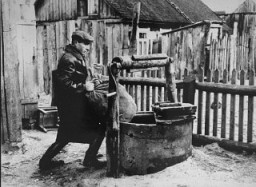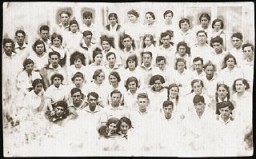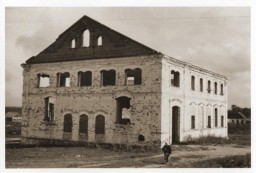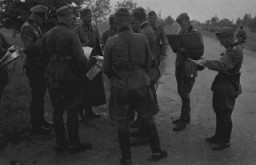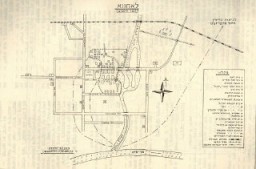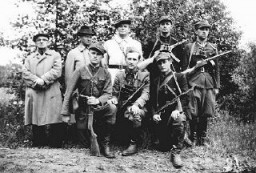Stanisławów
A Project of the Miles Lerman Center
- Pre-1939: Stanisławów, city and province capital in Poland
- Fall 1939 to June 1941: Stanislav, Ukrainian SSR
- 1941-44: Stanislau, capital of the Stanislau Kreis, Distrikt Galizien, Generalgouvernement
- 1944-91: Stanislav, (renamed in 1962: Ivano-Frankivsk), province capital, Ukrainian SSR
- Post-1991: Ivano-Frankivsk, independent Ukraine
Stanisławów was founded in 1654 by Count Jendrzej Potocki and in 1662 Jews received the right of permanent settlement in the town. During the eighteenth century the Jewish population thrived, displacing the Armenians as the leading merchant community. Under Austrian rule, Jews played quite an important role in civic affairs, such that from 1897 to 1919 Arthur Nemhein, an assimilated Jew, was the mayor. Jews in the city supported a variety of charitable organizations, ran their own educational institutions, including the Or Hayyim Yeshiva, and supported a variety of political organizations, including the assimilationist Shomer Israel and from the 1880s the Zionists. By the early twentieth century the city was a major center of Jewish manufacturing, especially in the clothing and hide-processing branches. In 1920 some Jews became victims of roaming Petlyura forces and others died of hunger and disease.
In 1910 there were 15,253 Jews living in the city out of a total population of 33,280. According to the 1931 census there were 24,825 Jews (in a total population 72,350). On the outbreak of World War II there were probably still about 25,000 Jews living in Stanisławów.
From September 1939 until the German attack on the Soviet Union on June 22, 1941, Stanisławów was under Soviet occupation. On July 2, 1941, Hungarian troops occupied Stanisławów and by the end of July the Germans had taken over control of the city. On July 26, 1941, on the orders of the Gestapo, a Judenrat (Jewish council) was established to organize Jewish life and—above all—to implement German orders. The chairman was Israel Seibald, who had been active within the Jewish community before the war. His deputy was the lawyer Michael Lamm. The Jewish Council was ordered to establish a Jewish police, the so-called Ordnungsdienst (Order Service).
On August 1, 1941, Galicia became the fifth district of the General Government. One day later SS-Hauptsturmführer Hans Krüger ordered Seibald to draw up a list of Jews who belonged to independent professions and these men were ordered to come to the Gestapo headquarters on Bilinski Street. As they thought they would get new jobs, many of them (more than 500) turned up. Only a few members of the “intelligentsia” tried to hide. On August 3, members of the SS and the Gestapo were waiting for the different groups. Survivors describe how they were tortured and most were killed afterwards in a nearby forest. Their families did not learn the truth for quite a while and continued to send packages, as they were told that their husbands were being held in prison.
After this Aktion against the intelligentsia the German administration issued similar anti-Jewish decrees as in the rest of the General Government after September 1939. Jews were required to wear white armbands with a blue Star of David. Marked like this they were easily identifiable as Jews and it became unsafe for them to walk on the streets. Male Jews in particular were taken without warning for forced labor, such as repairing streets or bridges. Women were also forcibly co-opted, for example, to perform cleaning jobs. To end this chaotic situation the Jewish council instructed the lawyer Dr. Tenenbaum to set up a Labor Office. Every day the registered Jews had to assemble at the Labor Office to be sent to perform various kinds of forced labor for the Germans. Later on in the ghetto it was this office that organized Jewish work details that went outside the ghetto. The Gestapo also demanded contributions, which the Jewish council collected from among the Jewish population. Then they demanded all the valuables that the Jews still possessed. Germans in uniform also entered Jewish houses to plunder them. In addition, the German civil administration, under Kreishauptmann Heinz Albrecht and Stadtkommissar Emil Beau, drew up plans to establish a ghetto.
Before the Jews were enclosed in a ghetto, the Germans wanted first to “decimate” them. On October 12, 1941, they demonstrated how they meant to “solve” the “Jewish Question” in the area. This day was later called “Blutsonntag” (“Bloody Sunday”). Unlike the other districts of the General Government, in the region of Stanisławów the local German administration did not wait until the killing centers had been established. Thousands of Jews were gathered on the market square; then the German forces escorted them to the Jewish cemetery, where mass graves had already been prepared. On the way the German and Ukrainian escorts beat and tortured the Jews. At the cemetery the Jews were compelled to give away their valuables and show their papers. Some of them were then released, but the majority had to remain. The men of the Security Police (Sipo) then started the mass shootings, assisted by members of the German Order Police (Ordnungspolizei) and also the railroad police. Krüger personally took part in the shootings. The Germans ordered the Jews to undress in groups and then proceed to the graves where they were shot. They fell into the grave or were ordered to jump in before being shot.
Some survivors have described the massacre in detail, revealing the incredible brutality applied by the German forces. Many survivors remember how bravely Dr. Tenenbaum of the Jewish council went to his death. Krüger, the head of the Gestapo, offered to set him free, but Tenenbaum said that he rejected this offer from a murderer and that he wanted to die with his brethren. In the evening those Jews still alive were allowed to leave the cemetery. The German forces shot between 8,000 and 12,000 Jews on that day. Seibald, the chairman of the Jewish council survived the massacre, but lived in hiding afterwards. Most probably he was also killed later on. On the day after the bloodbath, Lamm was called to the Gestapo headquarters, where they informed him that he would be the new chairman of the Jewish council. Among the members of the Jewish council in the ghetto was the engineer Julian Feuerman, who wrote a personal testimony in 1943 while he was in prison, but did not survive the war.
After the mass murder, the civil administration began preparations for the move of the remaining Jews into the designated ghetto area. The Jewish council succeeded in negotiating with the Germans about the inclusion of certain specific streets, but by the end of October the final borders had been determined. As was the case almost everywhere in occupied eastern Europe, in Stanisławów the Germans selected the oldest and most neglected part of the city to become the ghetto. The exact number of Jews in the ghetto is not known, but at least 20,000 Jews were compelled to live in this very small and densely overcrowded area. Those who lived outside the ghetto were required to move inside between December 1 and 15, 1941. Many Jews did not manage to find a roof over their heads and the Jewish council had to put them up in every available space, including storehouses and synagogues. During the month of November the “Aryan” population living in this part of the city had to move out.
The ghetto was officially closed on December 20, 1941, with a wooden fence separating it from the rest of the city. In those houses directly on the ghetto’s perimeter the windows had to be blocked with wooden bars. There were three gates, each guarded by German Schutzpolizei and the Ukrainian militia on the outside, and by the Jewish police on the inside. The commandant of the Jewish police was Zahler, a former sergeant in the Polish army. About one hundred Jews served in the ghetto police.
Jews were only permitted to leave the ghetto to perform forced labor. Several factories were established were they worked for the Germans. The Jewish Labor Office organized these factories under its new chairman, Horowitz, who succeeded Dr. Tenenbaum. The Labor Office issued identity cards to the workers. Many Jews worked outside the ghetto for various German institutions, at factories in the city and also on farms. Salomon Günsberg recalls:
“The Jewish population carried out work under the most difficult circumstances, virtually without any tools and they were beaten during the work.”
The living conditions in the ghetto were catastrophic. The sanitary conditions were dreadful: hunger and various diseases became permanent companions for the Jewish population. The official rations were far too small; more and more people died of hunger. The hospital was overcrowded. Already during the first winter in the ghetto, many people died of hunger and the cold. Only those with some money left were able to buy extra food on the black market, which had to be smuggled into the ghetto; but only a few people could afford the exorbitant prices demanded. It was possible to sell things legally to the “Aryan” population in a shop established and run by Eckhaus, a member of the Jewish council.
The Jewish council with Lamm as a head and Mordechai Goldstein as his deputy tried to organize life and social welfare under these difficult conditions. Many different departments were established in the Jewish council for this purpose. Most were directed by members of the Jewish council. One of the most important departments was the supply division, which organized food supplies for the population. The Beschaffungsamt (department for food procurement) had to “calm down” members of the Gestapo and Schupo with bribes of money and other valuables. There was also a branch of the Jewish Social Welfare (Jüdische Soziale Selbsthilfe – JSS) set up in Stanisławów, which received some money every month from the headquarters of the JSS in Kraków. But all these efforts to support the numerous poor inmates of the ghetto remained inadequate. Living conditions in the overcrowded ghetto became worse and worse.
By the end of March 1942, Krüger told Lamm that only 8,000 Jews could remain in the ghetto and the rest—old and sick people or beggars—would be taken to a labor camp. He ordered Lamm to hand over these Jews. When Lamm refused to comply, German police and Ukrainian auxiliary police surrounded the ghetto during the night of March 31, 1942. In a brutal raid they expelled many Jews from their houses and drove them to Belwederska Street. Houses were set on fire in order to force hidden Jews to come out. They had to march to the train station where wagons were already waiting and the people were deported to the killing center in Belzec. After these first deportations the ghetto was reduced in size and the German authorities instructed the Labor Office to prepare new lists of those Jews able to work and those who were not. The Jews were divided into three categories:
- young and healthy Jews working in important factories or institutions
- Jews able to work but without employment at the moment
- the weak, old, or sick Jews
After this registration, thousands of Jews belonging to category C were murdered, probably shot. Life became more and more unsafe: only Jews fit to work were allowed to live in Stanisławów. The German police frequently searched the ghetto for Jews of category B, who had not yet found a place to work.
The civil authorities also began concentrating the Jews from smaller communities such as Kalusz, Nadworna or Tlumacz, in Stanisławów. Most of them were then murdered in successive actions. These killings were carried out in the Rudolfsmühle (Rudolf’s Mill), a three-story building that was a grain mill. Here the Germans concentrated old and sick people along with Jews from Ruthenia. Jews with invalid work permits or those caught smuggling were also taken here. Living conditions were even worse than in the ghetto. Ukrainian auxiliary police guarded the building on the outside and internally the guards were Jewish policemen. Krüger had ordered all sick Jews in Rudolf’s Mill to be killed. Due to conditions in the building and the already poor health of the prisoners, most of them soon became sick.
Directly under the control of the Judenreferent (official for Jewish affairs) Schott, Rudolf’s Mill was a place of terror and mass murder. Schott personally took part in many of the shootings. Schupo Lieutenant Ludwig Grimm often joined him in carrying out the shootings. After the first deportations to Belzec, Jews were regularly taken to Rudolf’s Mill and shot there. Up to July 1942 most killings were carried out in Rudolf’s Mill, and from August onward, in the courtyard of the Sipo headquarters. At this time the head of the Jewish council was Goldstein, the former deputy head. It is not known exactly when Lamm was murdered and Goldstein succeeded him, but he was probably shot in a nearby forest together with other members of the Jewish Council in June or July 1942. On August 22, 1942 the Germans also killed Goldstein. He was hanged publicly as the first symbolic victim during a “reprisal Aktion.” The alleged “reason” for this “reprisal” was the murder of a Ukrainian, which the Germans blamed on a Jew. The Schupo commander Walter Streege led this Aktion. More than 1,000 Jews were shot. The German policemen raped some Jewish girls and women before taking them to the courtyard of the Sipo headquarters. Streege also ordered the hanging of about twenty members of the Order Service, the Jewish police. The Germans left the dead bodies hanging there for two days as a means of deterrence and to terrorize the Jews.
The next head of the Jewish council in Stanisławów was Schönfeld. According to the accounts of survivors, he apparently proved to be unscrupulous and a loyal servant of the Germans. He organized a new Jewish police for this purpose, of which he also became the head. About 11,000 Jews were still living in Stanisławów when the next Aktion took place. On Rosh Hashanah, which was on September 12, 1942, about three or four thousand Jews were deported to Belzec. On October 15, 1942, the Jewish population in Stanisławów was largely annihilated. Only a few Jews who continued to work for various German offices remained alive.
In January 1943 there were no more deportations to the death camp in Belzec, but the police continued to carry out shootings of Jews. On February 22 or 23, 1943, Brandt, who had succeeded Krüger in August 1942, ordered the police forces to surround the ghetto—initiating the final liquidation. People were brutally taken from their houses and driven to the Jewish cemetery, where the German police shot them. Among the victims was also the head of the Jewish council. Many Jews had prepared hiding places, but due to lack of water and food most of them soon emerged and were captured. Four days after the beginning of the Aktion, the Germans put up posters announcing that Stanisławów was “free of Jews.” According to Jewish testimonies, about five hundred Jews still remained in the city for various work tasks, but these people were also gradually shot in turn. On June 25, 1943, most of the last Jews still living “legally” in Stanisławów were also shot. Only a few expert professionals such as engineers and technicians were still kept in the central prison.
When the Soviet army reached Stanisławów on July 27, 1944, there were about one hundred Jews in the city who had survived in hiding. In total about 1,500 Jews from Stanisławów survived the war.
A formal indictment against Hans Krüger was issued in October 1965, after six years of investigations by the Dortmund State Prosecutor’s Office. On May 6, 1968 the Münster State Court sentenced him to life imprisonment. He was released in 1986. In Vienna and Salzburg there were other trial proceedings against members of the Schupo and the Gestapo in Stanisławów in 1966.
Sources
The testimonies of Julian Feuerman and Joachim Nachbar have been published: Julian Feuerman, “Pamiętnik ze Stanisławowa (1941-1943)” in: Biuletyn Żydowskiego Instytutu Historycznego 59 (1966), pp. 63-91; Joachim Nachbar, Endure, Defy and Remember. Memoir of a Holocaust Survivor (Southfield, Mich., 2003) [first published in 1977, by Joachim Nachbar]. There are many testimonies quoted in Elisabeth Freundlich: Die Ermordung einer Stadt namens Stanislau, (Vienna: Österreichischer Bundesverlag, 1986) and also Towiah Friedman (ed.), Schupo und Gestapo Kriegsverbrecher von Stanislau vor dem Wiener Volksgericht: Dokumentensammlung (Haifa: Institute of Documentation in Israel for the Investigation of Nazi War Crimes, 1957).
There are two excellent German studies about the annihilation of the Jews in Distrikt Galizien that contain much information concerning the events in Stanisławów: Dieter Pohl, Von der “Judenpolitik” zum Judenmord. Der Distrikt Lublin des Generalgouvernements 1939-1944 (Frankfurt am Main: Peter Lang, 1993) and Thomas Sandkühler, „Endlösung“ in Galizien. Der Judenmord in Ostpolen und die Rettungsinitiativen von Berthold Beitz 1941-1944 (Bonn: Dietz, 1996). Dieter Pohl has also published an article mainly focused on Stanisławów: “Hans Krüger and the Murder of the Jews in the Stanisławów Region (Galicia)” in Yad Vashem Studies 26 (1997), pp. 239-264. In Pinkas Hakehillot Polin: Encyclopedia of Jewish Communities, Poland, Volume II, Eastern Galicia (Jerusalem: Yad Vashem, 1980) on pages 359-67 there is an entry about Stanisławów.
There are many survivor testimonies in the Jewish Historical Institute in Warsaw and in the Yad Vashem Archives in Jerusalem. Especially RG-302 (Diaries and Testimonies) at the JHI contains several very detailed and useful personal accounts. Contemporary German documentation on the administration of Distrikt Galizien can be found in Archive of the Institute for National Memory (IPN) in Warsaw, the Archive of New Documents (AAN) in Warsaw and documents from Stanisławów itself in the State Archive of the Ivano-Frankivsk Oblast (DAIFO). The documents from the Stanislau trial in Münster against Hans Krüger and others can be found in the Zentrale Stelle Dortmund (ZSt Dortmund), the Bundesarchiv-Aussenstelle Ludwigsburg (BA-L) and also in the Institut für Zeitgeschichte, Munich (IfZ).
Series: Resistance in the Smaller Ghettos of Eastern Europe
Critical Thinking Questions
- Learn about the lives of the Jews in the community of Stanisławów before 1939.
- Learn about the history of the Jewish community in your country.
